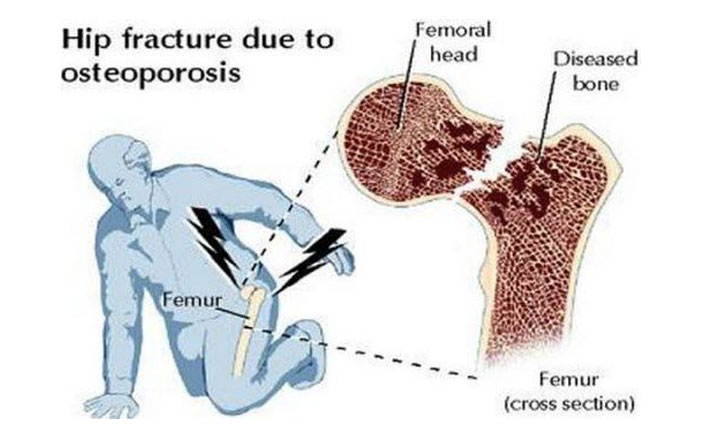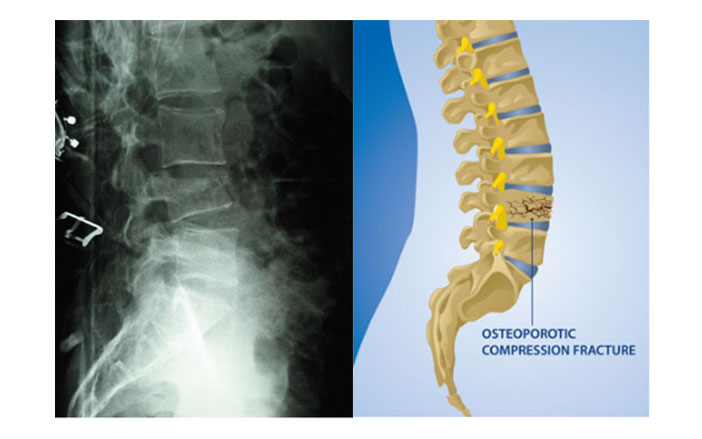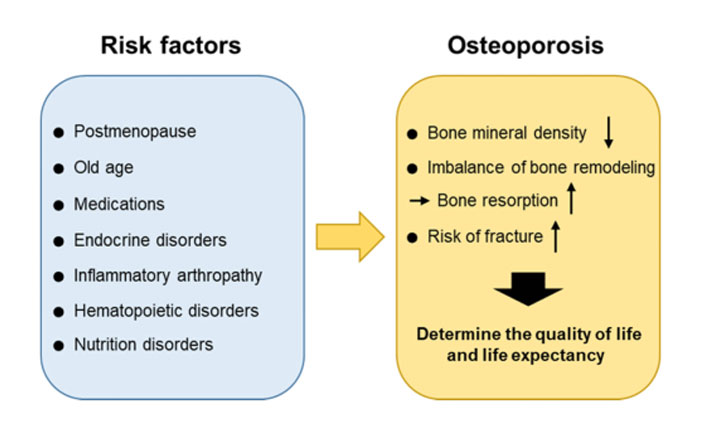What causes Osteoporosis?
Your bones are living tissue, the inside of which looks like a honeycomb. This spongy bone is called trabecular bone. It is surrounded by an outer dense bone known as cortical bone. In osteoporosis, the inside of the bone becomes weaker and the ‘holes’ in the ‘sponge’ grow larger. Osteoporotic bone lose calcium and becomes less dense. These fragile bones are very weak and prone to fractures. The fracture can be either in the form of cracks (like in hip, wrist) or a collapse (as in a compression fracture of the vertebra).
What are the symptoms of Osteoporosis?
In the early stages of the disease, there are almost no symptoms or warning signs. In most cases, people get to know about it after they have sustained a fracture.
Once your bones have been weakened by osteoporosis, you may have these signs:
Back Pain – Can also be due to a collapsed vertebra
Loss of height over time
Change in posture – stooping or bending forward
Bone fractures
Joint and body pains
Osteoporosis is COMMON AND SERIOUS!
The risk of getting osteoporosis increases with age after the age of 50 years and hence the risk of fractures also increases. The broken bones after healing may cause permanent pain, stooped postures and disability. It also limits mobility which leads to isolation, depression and long term nursing care. About 20-30 percent of senior citizens who get a hip fracture due to osteoporosis are likely to die within one year of injury from various complications.
Risk Factors for developing Osteoporosis
The two most important risk factors for developing Osteoporosis are gender and age.
Everyone is at risk of developing osteoporosis and osteoporotic fractures with increase in age. In women, the hormone estrogen protects against excessive bone loss in younger years. After the age of 50 years or in postmenopausal women, the amount of estrogen in females decreases increasing the risk of osteoporosis. They undergo rapid bone loss in the first 10 years after entering menopause.
Family History – You have a greater risk if your parents/grand parents had any signs of osteoporosis.
Lifestyle – Sedentary lifestyle, lack of exercises increases the risk.
Alcohol and tobacco consumption.
Dietary factors such as low calcium intake, low Vitamin D levels, eating disorders, history of bariatric surgery, celiac disease.
Medical conditions – A lot of medical conditions and treatments increases the risk of osteoporosis such as:
- Overactive thyroid, parathyroid or adrenal glands
- Hormone treatment for cancers
- Inflammatory bowel disease
- Medications such as steroids, anti-seizure, chemotherapy etc.
- Chronic kidney disease, liver disease
- Organ transplants etc.
How is Osteoporosis diagnosed?
After a detailed history of your symptoms, your doctor will advice a Bone Mineral Density (BMD) test, also known as Dual-energy X-ray absorptiometry (DEXA) scan. It uses very small amounts of X-ray radiation to determine how solid the hip and spine are. The results are in the form of T and Z scores which classify the patient as normal, osteopenia or osteoporosis. People above the age of 65 years should get their bone density checked regularly.
A routine X-ray also reveals osteoporosis as bones appear thinner and lighter than normal bones. Unfortunately, by the time these findings appear on the X-ray a lot of bone is already lost.
How to prevent Osteoporosis?
DietSince bones are made up of calcium, you need a diet rich in calcium to keep them strong and healthy. The recommended daily allowance of calcium is 1000-1200 mg. Some good sources of calcium rich foods include:
> Dairy products
> Green leafy vegetables
> Fish
> Soy products
> Fruits and juices
If your diet is inadequate to provide sufficient daily calcium, then you must take calcium supplements. Calcium supplements should be taken in divided doses since calcium absorption is not readily absorbed.
Vitamin D is also important for maintaining bone health. Vitamin D improves the body’s ability to absorb calcium. The recommended daily allowance of Vitamin D is 600-800 IU. Vitamin D is produced by the body from sunlight exposure but this might not be enough if your sunlight exposure is less or if you regularly use sunscreen. People not getting enough Vitamin D need to take supplements.





